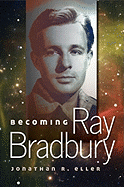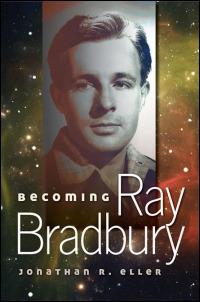
 It may be hyperbolic to suggest that Ray Bradbury is the science fiction writer most likely to have been read by any randomly selected American under the age of 50. Given the frequency with which junior high and high school English teachers assign Fahrenheit 451 or, perhaps, The Martian Chronicles, though, it doesn't seem like a completely unreasonable assumption. Younger readers may not be aware of how brightly Bradbury's literary star shone when those books were first published; although he could never fully disassociate himself in the minds of the literati from the genre label, support from mainstream magazine editors and enthusiastic, influential readers like Christopher Isherwood at least assured he would be regarded as the one diamond in a pile of coal.
It may be hyperbolic to suggest that Ray Bradbury is the science fiction writer most likely to have been read by any randomly selected American under the age of 50. Given the frequency with which junior high and high school English teachers assign Fahrenheit 451 or, perhaps, The Martian Chronicles, though, it doesn't seem like a completely unreasonable assumption. Younger readers may not be aware of how brightly Bradbury's literary star shone when those books were first published; although he could never fully disassociate himself in the minds of the literati from the genre label, support from mainstream magazine editors and enthusiastic, influential readers like Christopher Isherwood at least assured he would be regarded as the one diamond in a pile of coal.
The metaphor is chosen deliberately: much like a diamond is created by exerting intense geological pressures on coal, Bradbury's most famous stories came after years of refinement. In Becoming Ray Bradbury, Jonathan R. Eller painstakingly details the process by which the young writer consciously shifted his literary influences from pulp writers like Edgar Rice Burroughs and H.P. Lovecraft to literary figures like Thomas Wolfe and John Steinbeck. Drawing upon interviews with his subject, as well as access to his archival papers, and light critical analysis of the stories, Eller lays out Bradbury's tightrope walk along "the line between unrestrained individualism and the effective use of technique," resulting in short stories that used science fiction and fantasy tropes to reach out to larger audiences.
Though Bradbury actively sought literary recognition, even going so far as to ask Doubleday to take the identifying genre tags off his book jackets, it's important to remember that he never fully broke ties with science fiction. In particular, Eller discusses the ways in which friendships with writers like Henry Kuttner and Leigh Brackett helped the young writer find his voice. At the same time, taking inspiration from Howard Roark, the hero of Ayn Rand's The Fountainhead, Bradbury was (in Eller's words) "always on guard against a culture trying to hamstring his creative potential for commercial gain." If, as Malcolm Gladwell says, one needs to apply oneself for 10,000 hours to become an expert, let's call this a look at the 10,000 hours (give or take) that gave Bradbury the ability and the confidence to write Fahrenheit 451. It's a fantastic story, and one of the few frustrating things about it is that Eller ends it just as Bradbury, flush with success, is recruited by John Huston to write a screenplay for Moby Dick. Is it presumptous to ask for a sequel? --Ron Hogan
Shelf Talker: Jonathan R. Eller, a co-founder of The Center for Ray Bradbury Studies, gives us an insightful critical account of an American literary icon's formative years.

